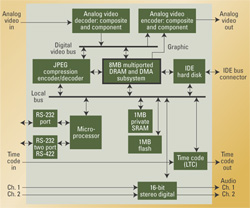The advantage of Motion JPEG
MPEG has sometimes been cited as a preferable compression method to Motion JPEG (MJPEG) for digital video recording. This viewpoint has been based primarily on the larger memory requirements for MJPEG over MPEG. However, there has been a resurgence of interest in MJPEG and there are several factors behind this trend.

Turner Sports uses the MJPEG-based Omega Deck DDR for its sports broadcasts. The benefit of MJPEG in live sports events is that it ensures that individual frames, taken in any sequence, will look good every time.
First of all, MJPEG requires a simpler hardware and data processing scheme, thus reducing the total product cost. Because MJPEG compresses similar data within each frame only, the hardware required for record and playback is not only symmetrical but also simpler and less expensive than MPEG. Also, the ability to have access to each frame of video allows for high-quality, variable-speed replay of video in both forward and reverse. This is not only a benefit in sports broadcasting and video analysis, but it also allows access to each native frame for easy implementation of graphics overlay and editing functions. Finally, the quality of recorded video using MJPEG is often better than MPEG because less compression is used.
Then there is the issue of timing accuracy. MPEG encoding can’t guarantee the accuracy offered by the frame-based MJPEG compression scheme, though it does come close with MPEG intra-frame (I-frame) compression. I-frame compression compares consecutive video frames to consolidate common elements and then preserves difference information. Standard MPEG compression is based on a group of pictures (GOP) that comprises the number of bi-directional (B) and predictive (P) frames between each successive I-frame. See Figure 1 for an example of how MJPEG is used in DVR products.

South Dakota Public Broadcasting has selected Media 100’s 844/X editing system for the creation of on-air opens, promotions, and network image spots. Click here to see an enlarged diagram.
Because MPEG must include these B and P frames, neither long GOP or short GOP stands up to independent viewing or editing as well as MJPEG. As a result, it is more difficult to attach a frame ID through time code or another scheme, and the possibility of encountering questionable in-between (“tweener”) frames is raised. Frame-based MJPEG compression eliminates this concern, allowing for quick and efficient processing and facilitating applications that can be difficult to accomplish using MPEG compression. Variable-speed playback, such as that required in live sports broadcasts, is more difficult with MPEG but easily accomplished with MJPEG because each frame is preserved.
MJPEG in action
Turner Sports selected the MJPEG-based Omega Deck DDR from Fast Forward Video as the solution for all major sports broadcasts seen on TNT, TBS Superstation and Turner South.
Get the TV Tech Newsletter
The professional video industry's #1 source for news, trends and product and tech information. Sign up below.
During live sports events Turner’s playback operators must be able to freeze any frame and know that it will be a faultless picture each time. Using MJPEG, any frame taken in any sequence will look perfect every time. The operator can freeze a frame and then move forward or back without being concerned that a selected point may fall somewhere between two complete frames.
The Omega Deck features the familiar controls, inputs and outputs of standard analog tape decks. It provides full random access. In addition to networking and playback functions, the DDR features a LCD touch-screen menu and front-panel control. Operator selections include compression levels, recording options, playback looping, genlock timing and playlist creation, as well as dynamic tracking, slow motion, instant cueing and jog/shuttle functions. The system’s low 2:1 compression ratio and CCIR-601 4:2:2 recording allows Turner Sports to play out animations, banners, logos and other graphics smoothly and quickly.
When simultaneous rolls are running from multiple channels on the Omega Deck, they are frame-accurate, and the fill and key match every time. This would be virtually impossible on an MPEG-based system. Using the Omega Deck’s loop feature, Turner Sports can create a segment of video with an opening animation and a back half consisting of a background that loops. For instance, within a seven-second clip, a four-second introduction is followed by three seconds that loop continuously. MJPEG compression makes this possible with accuracy that ensures the clips will always match with a perfect join.
MJPEG technology offers easy post-record editing and individual frame capture and examination. It also provides a flexible solution that balances the need for high-quality, frame-based, scalable compression to the requirements of the application. The ability to record and examine individual video frames with standard PC-based programs, such as QuickTime, over a networked system is a benefit in many broadcast applications. With memory costs dropping, look for even more MJPEG solutions to be available soon.
Tom Sahara is senior director of remote operations and IT at Turner Broadcasting, and Wes Morgan is vice president of business development at Fast Forward Video.
